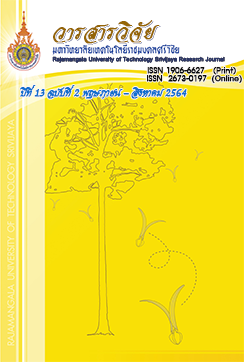A Study on Activated Asparagus Seeds by Electric Field Combined with Ozone Water Technique
Keywords:
Ozone, , Electric Field, germination rate, asparagus seedsAbstract
This research examines the activated of asparagus seed germination with the combination of electric field and ozonated water technique. It aims to explore the germination rate of asparagus seed and the length of the root in comparison to non-stimulated asparagus seeds. The experiment was conducted using the 1-5 kV/cm uniform electric field for a period of 20, 25, and 30 minutes and the 0.5-2.3 ppm ozonated water for a period of 10, 20, and 30 minutes, respectively. The result revealed that in terms of the germination rate of asparagus seed and the length of the root, asparagus seeds that have been activated with the combination of electric field and ozonated water technique have the best result. The combination of using the 3 kV/cm electric field for 30 minutes and the 2 ppm ozonated water for 20 minutes obtains the highest seed germination rate at 98.45 percent and the longest length of the root at 1.8 centimeters. Comparing to the nonactivated asparagus seeds, asparagus seeds that have been stimulated with the combination of electric field and ozonated water technique yield a better seed germination rate of 29.45 percent higher than non-stimulated seeds and a better length of the root ratio of 88.88 percent longer than non-stimulated ones.
References
Berton, L., Filho, J., Siqueira, W. and Colombo, C. 2013. Seed germination and estimates of genetic parameters of promising macaw palm (Acrocomia aculaeta) progenies for biofuel production. Industrial Crops Products 5(1): 258-266.
Hasan, N., Ahmad, N., Zohrameena, Sh., Khalid, M. and Akhtar, J. 2016. Asparagusracemosus: for Medicinal Use & Pharmacological Actions. International Journal of Advanced Research 4(3): 259-267.
Kuffel, E., Zaengl, W.S. and Kuffel, J. 2000. High Voltage Engineering: Fundamentals. 2nd ed. Newnes, Great Britain.
Mahajan, T.S. and Pandey, O.P. 2014. Effect of electric field (at different temperatures) on germination of chickpea seed. African Journal of Biotechnology 13(1): 61-67.
Molamofrada, F., Lotfia, M., Khazaeib, J., Reza T.A. and Amir, S.A. 2013. The effect of electric field on seed germination and growth parameters of onion seeds (Allium cepa). Advanced Crop Science 3(4): 291-298.
Patwardhan, M.S. and Gandhare, W.Z. 2013. High voltage electric field effects on the germination rate of tomato seeds. Acta Agrophysica 20(2): 403-413.
Sajjanit, C. 2009. Non-Tariff Barriers (NTBs): Key trade barriers for Thai exporters. Sripatum Review Humanities and Social Sciences 9(2): 125-134. (in Thai)
Shorstkii, I.A., Zherlicin, A.G. and Li, P. 2019. Impact of pulsed electric field and pulsed microwave treatment on morphological and structural characteristics of sunflower seed. Oilseed & Fats Crops and Lipid Journal 26(47):1-7.
Soltani, F., Arghavani, M. and Kashi, A. 2006. Effect of magnetic field on Asparagus officinalis L. seed germination and seedling growth. Seed Science and Technology Journal 34(2):349-353.
Srikanth, D., Kumar R.P., Khandka, S. and Jyothi, G.B.N. 2018. Influence of magnetic and electric field on germination attributes of chilli (Capsicum annum L.) seeds. International Journal of Pure & Applied Bioscience 6(3): 496-501.
Sudhakar, N., Nagendra, D., Mohan, N., Bradford, H., Gunasekaran, M. and Murugesan, K. 2011. Assessing influence of ozone in tomato seed dormancy alleviation. American Journal of Plant Sciences 2(1): 443-448.
Suteerapoj, W. 2019. Product of Vegetable Fresh Fruit Frozen and Dried: Basic Data of Product. Available Source: https://www.
ditp.go.th/ditp_web61/article_sub_view.php?filename=contents_attach/526062/526062. pdf&title=526062, January 20, 2019. (in Thai)
Tataranni, G., Sofo, A., Casucci, C. and Scopa, A. 2013. Different root growth patterns of tomato seedlings grown hydroponically under an electric field. Japan’s Academic Journals 7(1): 28-32.
Violleau, F., Hadjeba, Kh., Albet, J., Cazalis, R. and Surel, O. 2007. Increase of corn seeds germination by oxygen and ozone treatment. IOA Conference and Exhibition Valencia 6(5) :1-6.
Watanabe, S.I., Inoue, K., Emoto, S., Ishibashi, Y., Doi, K. and Furuya, Sh. 2014. Trial of green asparagus out-of-season production for establishing year-round production in Kyushu, a warm area of Japan. Japan Agricultural Research Quarterly Journal 48(4): 449-455.
Wichamanee, Y. 2013. Factors influencing on dewatering by osmotic dehydration of fruits and vegetables. Burapha Science Journal 18(1): 226-223. (in Thai)
Wongsinchuan, N., Buatip, S. and Hawo, T. 2013. Germination enhancement of palmyra seed (Borassus abellifer L.). Thai Agricultural Research Journal 31(3): 250-256. (in Thai)
Yasin, M. and Andreasen, C. 2016. Effect of reduced oxygen concentration on the germination behavior of vegetable seeds. Horticulture Environment and Biotechnology Journal 57(5): 453-461.
Downloads
Published
How to Cite
Issue
Section
License
The content and information in the article published in Journal of Rajamangala University of Technology Srivijaya It is the opinion and responsibility of the author of the article. The editorial journals do not need to agree. Or share any responsibility.







